14/07/2021
Covid-19 has dealt a significant blow to air travel demand in Europe, and the emergence of multiple variants and the relatively slow vaccination rollout have exacerbated the market's struggles.
For over a year, the pandemic's spread has restricted international, and in some countries even domestic, travel in Europe in a bid to keep infections at a manageable level. Intelligence from IBA's InsightIQ platform reveals air travel capacity in Europe was down 21% in June 2021 compared with the same month in 2019.
On 10th April 2021, the French parliament passed legislation to ban air travel for routes of less than 2.5 hours that can be replaced by direct High-Speed Trains (TGV). The French government's Climate Commission originally suggested a ban of all domestic flights that could be replaced by direct trains in less than 4 hours. This was rejected on grounds that banning all domestic flights at this level could weaken the desirability of isolated regions. Pressure from environmental groups continues in favour of prohibiting high-frequency routes such as Paris-Marseille and Paris-Toulouse.
Using InsightIQ's aviation data from the Flights module and its Carbon Emissions Calculator (CEC), we examined the impact of this legislation on French domestic air travel in the wider context of the pandemic, with a specific focus on Air France. With competition from other low-cost carriers (LCCs) and operating 76% of French domestic flights, what does this mean for the French flag carrier?
Due to its high reliance on international routes, IBA expects the European market to take longer to resume pre-pandemic air traffic levels compared with both the Asia-Pacific and North American markets. Domestic routes accounted for only 31% of the overall capacity in Europe in 2019, compared to 73% in Asia-Pacific. In Europe, the Russian market seems to be the most resilient domestic market so far, recovering a 28% capacity increase between June 2019 and June 2021.
Lockdown restrictions imposed by many European governments as a result of the third Covid wave severely effected the national operations of airlines in France, as shown in the graph below. In June 2021, domestic flights in France were still down 24% compared with pre-pandemic levels.
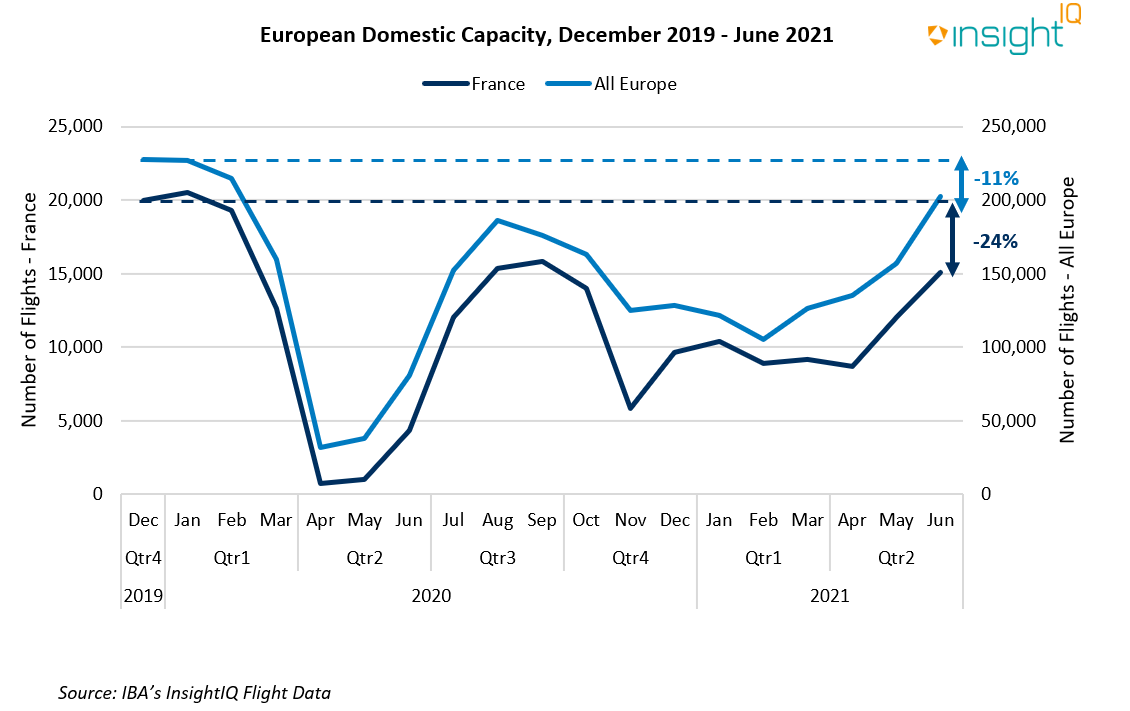
France was the fifth largest European domestic air travel market in June 2019, with a diversified operator base dominated by the Air France-KLM Group. The chart below shows the number of domestic flights between 2019-2021, both before and during the Coronavirus pandemic.
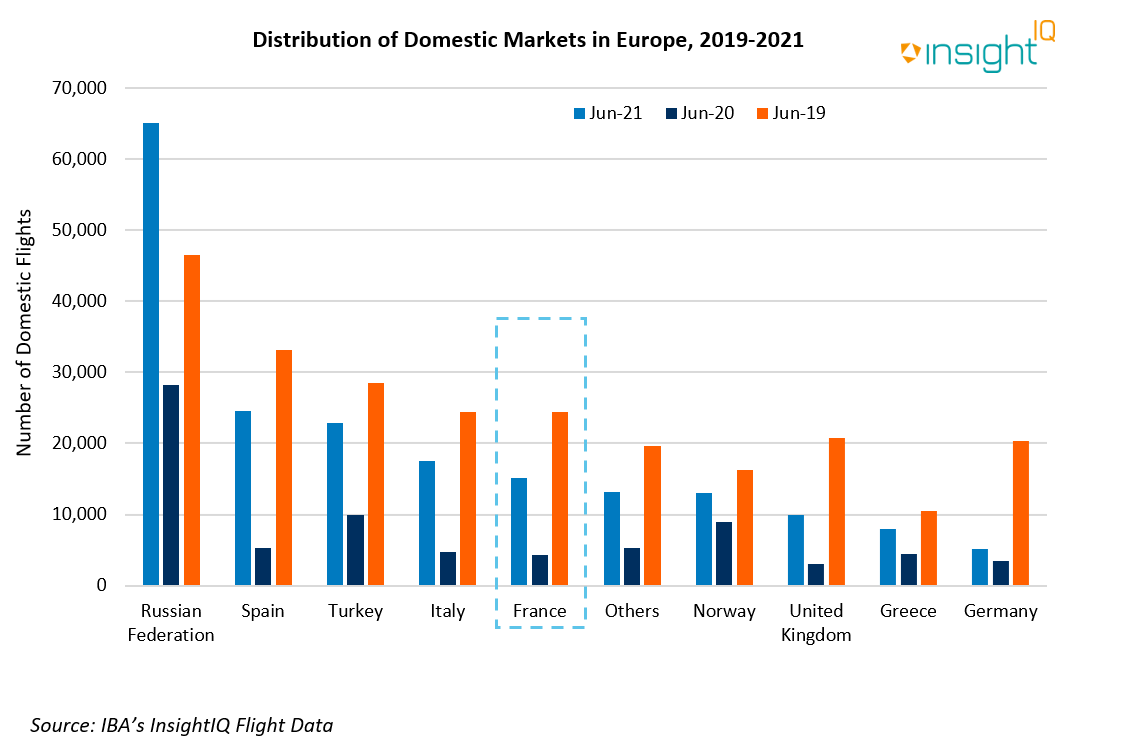
The Air France-KLM Group dominated the French domestic market in March 2019, with the group operating around 70% of all domestic flights in France. Two years later, although Air France and its regional subsidiary airline, HOP!, have lost a 15% market share in terms of capacity, Air France remains the largest operator within the French domestic market.
Low-cost carrier Transavia France, (owned by the Air France-KLM Group) started operations within the domestic market in late 2020. Transavia France's market share represented approximately 6% of the market in June 2021. Air Corsica (partnered with and partially owned by Air France) saw it's market share increase as the airline was contractually obliged by the French local authority to maintain a minimum level of regional connectivity between the French islands and mainland, regardless of air travel demand.
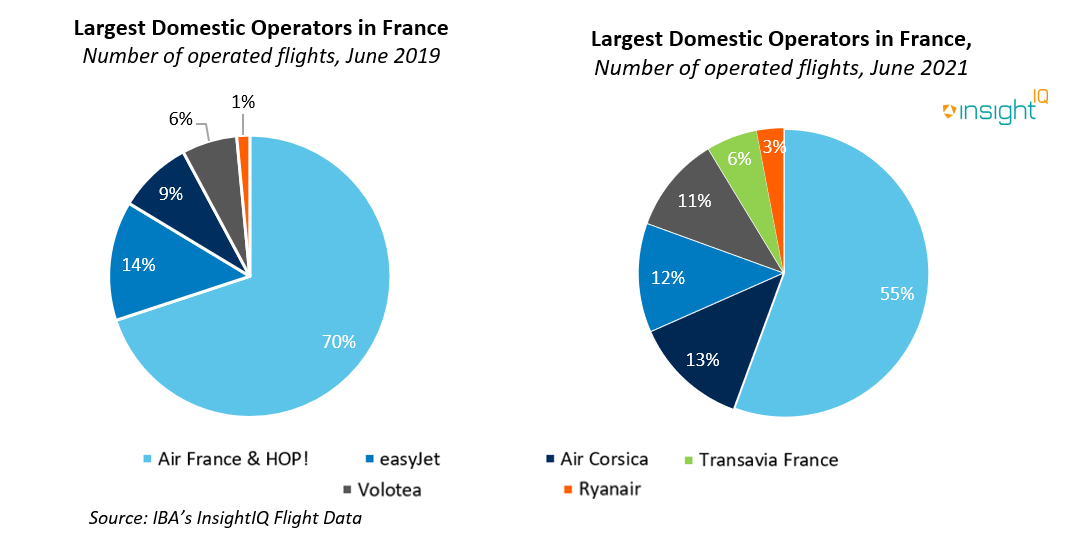
French Finance Minister Bruno Le Maire announced domestic connections subject to the restrictive measures would be focussed on those connecting Paris Orly airport, south of the French Capital. Restrictions would not effect travellers with regional short-haul routes connecting at Paris-Charles de Gaulle (CDG).
In real terms, this means that restrictions will only apply to 5 air travel routes.
Paris Orly - Bordeaux
Paris Orly - Lyon
Paris Orly - Nantes and
Paris Orly - Rennes
Lyon - Marseille
InsightIQ Flights data shows legacy carrier Air France and its regional subsidiary HOP! are the only airlines effected by the new legislation. Before Covid, the Group operated nearly 10,630 flights on the specified domestic short-haul routes in 2019, representing approximately 6.3% of all its domestic flights. 15.7% of all regional flights from Parisian airports were performed by the French carrier.
In total, four aircraft families were deployed with approximately ten aircraft models, from the Airbus A321 CEO to the ATR72-600. It is worth noting that Air France's A320 CEO family aircraft are typically deployed on routes that require more rotations and capacity, such as Paris-Orly to Bordeaux and Lyon. The HOP! fleet is centred around regional and turboprop aircraft.
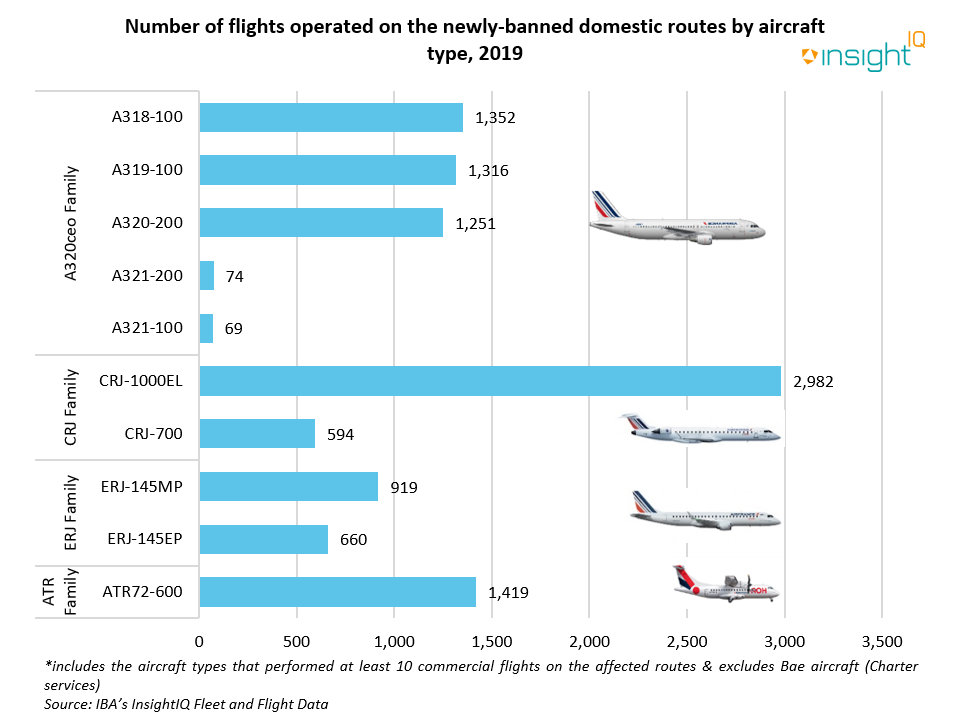
Using InsightIQ's new and unique Carbon Emissions Calculator, we can directly evaluate the ban's environmental impact in the form of CO2 emissions.
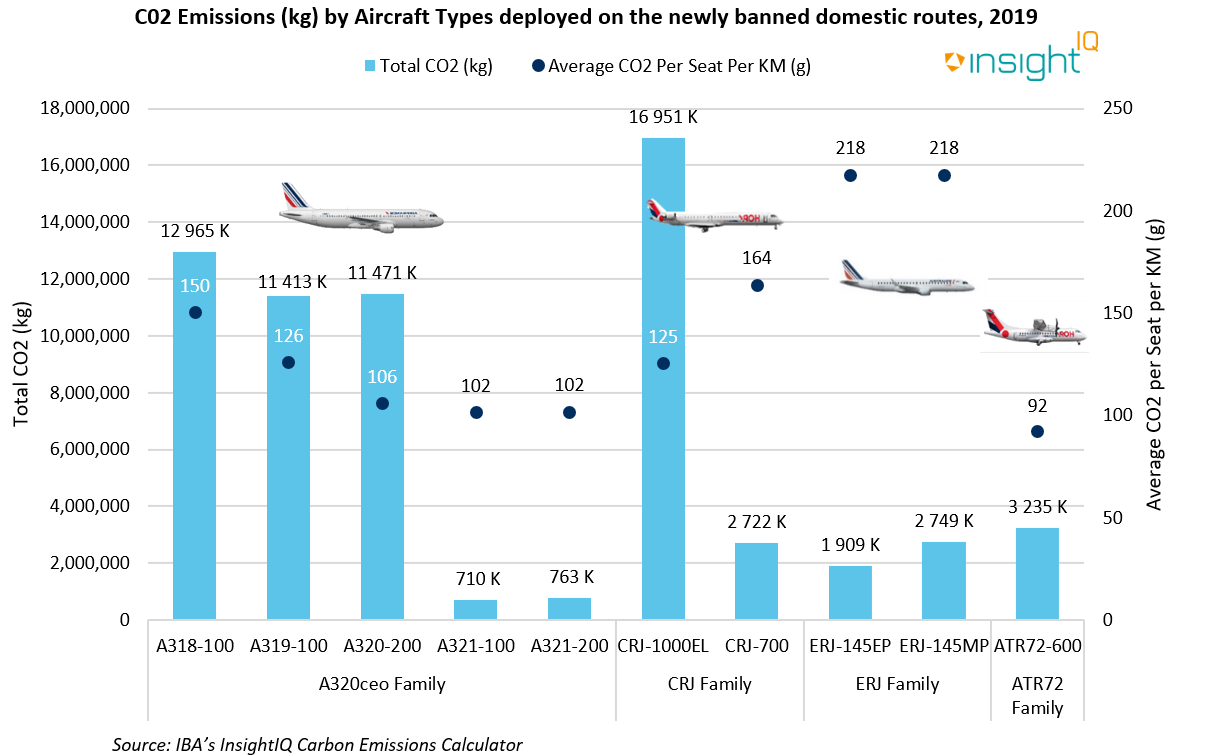
The A320 CEO family aircraft produced between 100-150 grams of CO2 per seat per kilometre (km) on average, while the ATR72 family aircraft had a lower carbon footprint on the same routes, averaging only 92 grams per seat per km. This is often a typical trend on routes operated by both jets and turboprops.
The A320 CEO aircraft have been utilised most on the five newly-banned domestic routes, representing 38% of all operated flights. This is due to the high frequency of Paris Orly to Bordeaux flights. The ATR72 family, with the lowest CO2 emissions among all the aircraft deployed on these domestic routes, operated only 13% of flights in 2019. The CRJ family was also heavily utilised on these journeys, operating 33.7% of all flights in 2019. The CRJ-700 and CRJ-1000EL aircraft both had relatively high carbon footprints, ranging between 125 and 164 CO2 g per seat per km.
Our Carbon Emissions Calculator (CEC) clearly identifies the ERJ-145 aircraft operated by HOP! as the highest CO2 emitter on an available seat basis, with an average of 218 CO2 g per seat per km. These aircraft types were operated on routes with reduced demand, in particular the very short trip between Marseille and Lyon.
CEC data shows HOP!'s regional fleet is comparatively less fuel-efficient on average than the aircraft operated by Air France on the same routes. Except for the few ATR aircraft deployed, most of HOP!'s aircraft emitted more CO2 on a per available seat basis than the A320 CEO's operated by Air France.
Ben Smith, Air France-KLM's CEO, announced this year that the Group would aim to make HOP! an all-Embraer airline, keeping only the E170 and E190 that did not fly on the effected domestic routes in 2019. He added that HOP! operations will be limited to routes from the Paris-CDG hub and Lyon airport.
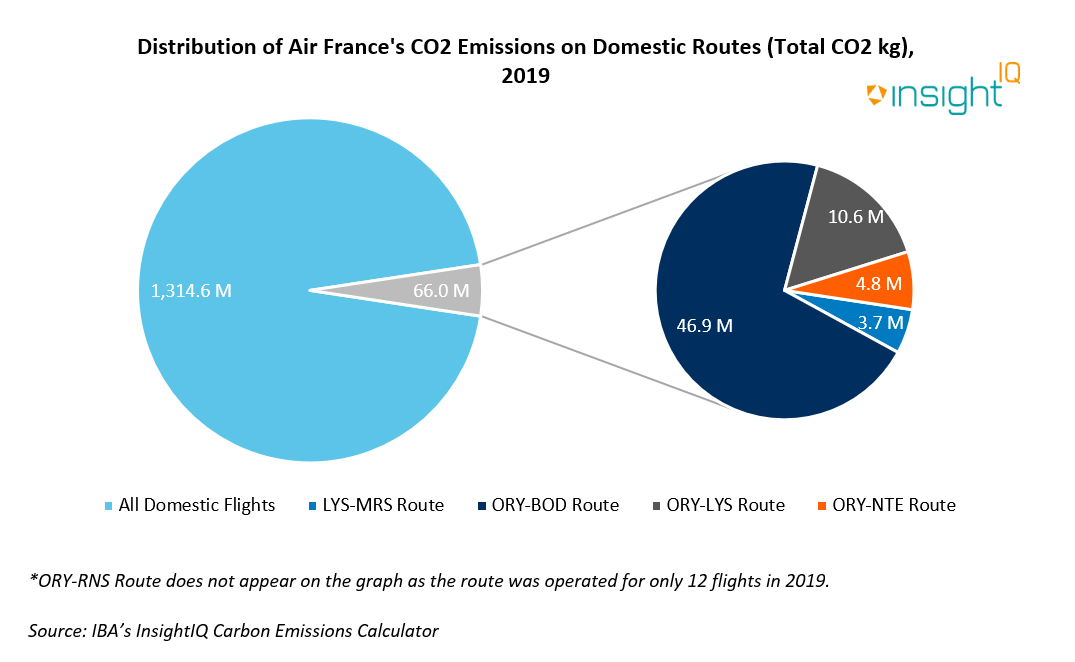
Data from our Carbon Emissions Calculator demonstrates that the removal of these 5 domestic routes will reduce total CO2 emissions from Air France and HOP!'s domestic operations by 4.8%.
2019 CEC figures also highlight the varying CO2 emissions on each of the withdrawn routes. Flights connecting Paris-Orly and Rennes had a limited impact on CO2 emissions due to the very limited number of flights in 2019. Conversely, the route linking Paris Orly and Bordeaux airport had the largest CO2 emissions due to the route's popularity. This led Air France to add more rotations and use aircraft with greater capacity (A320ceo family aircraft) resulting in further CO2 emissions.
The end of some short-haul internal flights by Air France comes after the carrier announced a restructuring plan effecting all second-tier city bases in France. It said it would close its bases at Marseille-Provence, Nice-Côte d'Azur and Toulouse-Blagnac airports by 2022. This move has been driven by heavy losses recorded by HOP! within the French domestic market. The shortfalls recorded by the regional operator are explained by the complex mix of aircraft types' high operating costs as well as fierce competition from Low-Cost Carriers on the same routes, including EasyJet, Ryanair, Volotea and Vueling. Since 2019, the domestic operators' landscape in France changed after Air France-KLM's CEO decided to make its Low-Cost Carrier Transavia France a key player in the French domestic market and to reduce Air France HOP!'s operations.
Air France-KLM Group is still struggling to deal with the Covid-19 pandemic and has requested more financial support from the French government. In March 2021, France approved a second bailout for the French-Dutch Group and initiated negotiations with the European Commission to obtain consent for the airline's rescue package without conceding airport slots. The French government managed to get the European Commission's agreement for support amounting to nearly US$ 4 billion, though the Group will have to abandon 18 daily slots at Paris-Orly airport. These slots are likely to be those related to the five abandoned Air France domestic routes.
If you have any further questions please contact Finlay Grogan.

IBA's InsightIQ analysis platform flexibly illustrates multiple asset, fleet and market positions, actual and potential, to inform client choices and identify acquisition opportunities. Immediate access to crucial aircraft, engine, lease rate and fleet data eases appreciation of historic and future aircraft concentrations and operator profiles.